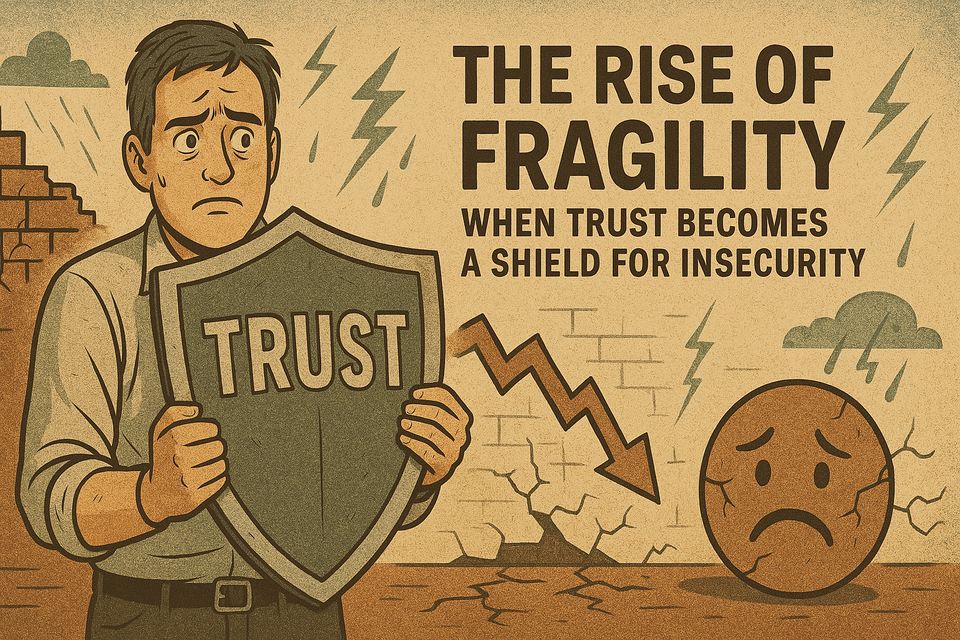The Rise of Fragility: When Trust Becomes a Shield for Insecurity

Fragility often manifests in two recurring patterns within companies struggling to grow:
- Straw man arguments – For example, claims such as "if we do not work for this specific client, it will be the end of the world" distort reality, creating unnecessary panic and justifying unsound decision-making.
- Fear-based narratives – Constant reminders about job market struggles, past layoffs, and external risks reinforce a protectionist stance, where employees prioritise personal security over the company's progress.
This is fragility at its peak: living in fear and resisting change. People adopting this stance want the benefits of a job without accepting its challenges. By positioning themselves as victims, they become vulnerable to internal manipulation, allowing others to exploit them through straw man arguments and fear-based blackmail. Instead of driving meaningful progress, they remain trapped in cycles of hesitation and risk avoidance.
An unfortunate cultural shift has taken place in modern workplaces:
- Autonomy is mistaken for isolation.
- Feedback is treated as an attack.
- Trust is demanded but never earned.
Instead of seeking clarity, teams hide behind ambiguity. Instead of leveraging expertise, they push back on accountability. This fragility manifests in:
- Working in silos and avoiding visibility.
- Rejecting structured growth because it feels uncomfortable.
- Dismissing external expertise instead of embracing it.
This does not reflect autonomy. It reflects fear. Fear of being challenged, fear of losing control, fear of realising that established ways of working no longer suffice.
Remote work has amplified these issues. Lack of visibility has enabled resistance to change, trust has become an excuse to block progress, and feedback loops have disappeared, reinforcing bad habits. Rather than fostering transparency, remote work has become a shield for avoidance. High-performing teams, however, have used remote work as a means to increase structure, discipline, and accountability. The more the distance, the more open processes need to be.
Restoring Order Through Strong Leadership
A strong leader plays a crucial role in restoring a better order. Leadership should not hesitate to continue pointing out the truth, asking the right questions, and demanding metrics and visibility. From this foundation, a leader can demonstrate better ways of working and provide guidance while allowing the team the opportunity to organise itself, provided that it delivers the expected outcomes.
The contract is clear: leadership does not seek to change personalities but rather to empower individuals to make their own choices, as long as the results are there. Metrics should underline improvements in customer experience, delivered in accordance with sound engineering practices. The team must achieve both efficacy and efficiency. If it fails to do so, this exposes gaps in the team's capabilities.
The contract remains fair: the team can choose how to approach the work, but it must deliver the expected outcomes. In cases where team members break this contract, it signals the moment to separate the chaff from the wheat, ensuring that only those committed to growth and accountability remain. Leadership does not impose unnecessary structure but ensures that work is result-driven and aligned with the company’s long-term success.
Conclusion: Leadership Means Breaking the Cycle
Fragility is no longer a phenomenon isolated to startups or struggling companies. This mindset has spread across industries, affecting organisations worldwide. In the current market, where competition is fiercer than ever, only the strongest companies—those with resilient teams and decisive leadership—will thrive. Companies that tolerate fragility, protect weak behaviours, and resist necessary change will not survive.
A weak leader accommodates fragility. A strong leader challenges it.
- They make trust a default rather than a negotiation.
- They expose silos and drive transparency.
- They dismantle resistance and turn it into momentum.
Organisations that refuse to address these issues will continue to stagnate. Those that enforce a culture of trust, accountability, and incremental progress will thrive. Every leader, at every level, must ask: Am I enabling fragility, or am I breaking the cycle?
A weak leader accommodates fragility. A strong leader challenges it.
- They make trust a default rather than a negotiation.
- They expose silos and drive transparency.
- They dismantle resistance and turn it into momentum.
A company unable to onboard seniority, embrace structure, or scale beyond its comfort zone will never reach the next level. The myth of "just delivering" will collapse. Only those who embrace professionalism, discipline, and trust will survive the transition to true maturity.
Real leaders do not protect the past. They build the future.
Breaking the Cycle: Fragility vs. Scalability in IT Teams
In the evolving landscape of IT, we see a growing rift between two types of teams: those that thrive on ownership and scalability, and those that struggle with a victim mentality, fragility, and a lack of accountability. The differences between these two are stark, and the impact is felt across engineering and product leadership.
The Fragile Teams: A Pattern of Excuses and Delays
Teams that operate with a fragile mindset exhibit recurring symptoms:
- Late Deliveries: They fail to meet deadlines consistently.
- Lack of Transparency: Processes are opaque, requiring leaders to chase updates.
- Absence of Metrics: No clear measures of efficiency, effectiveness, or progress.
- Resistance to Incremental Delivery: Everything is perceived as "difficult," leading to delays.
- Missed Demos and Ceremonies: Rituals that provide alignment and accountability are ignored.
- Excuses Over Action: Every challenge is met with complaints rather than solutions.
A key enabler of this victimisation mindset often stems from environments where "preserving the startup culture" is used as a shield to dodge discipline and sound engineering practices. While some startups successfully balance agility with structure, others use this mindset to justify poor execution and lack of accountability.
Another common justification for stagnation is seeking refuge in past trauma, such as layoffs or frequent leadership changes. While layoffs are undoubtedly traumatic, we must acknowledge that we work in a tough business where only the strong survive. Similarly, rapid leadership turnover often signals deeper issues. They often point to mid-level management resisting change and undermining growth efforts rather than external instability.
Ultimately, this highlights the necessity of a strong mid-level leadership layer. A well-structured mid-level leadership team acts as a stabilising force, ensuring that strategic vision translates into scalable execution. For example, in organisations that have successfully scaled, mid-level leaders play a crucial role in reinforcing best practices and preventing operational drift.
However, the truth often lies somewhere in between. One common pitfall is the habit of promoting Senior Software Engineers (SSEs) into leadership positions too early, without proper preparation. This can lead to impostor syndrome, where fresh leaders develop a protectionist stance, sometimes unintentionally undermining their teams' performance.
Symptoms of this issue include:
- Acting as bottlenecks rather than enablers.
- Becoming the sole communication channel, limiting team visibility.
- Overcompensating on the people's side of leadership to avoid losing team trust, while unintentionally alienating their team within the company.
Instead of fostering autonomy, these leaders create dependency, ultimately slowing down execution and decision-making.
The Scalable Teams: Leveraging Ownership and Real-Time Metrics
High-performing teams operate differently. They have built a culture of scalability and empowerment, enabling engineers to:
- Own Initiatives: Each engineer actively leads a piece of work, ensuring accountability.
- Continuously Evolve the Roadmap: The team collectively refines their goals.
- Engage Internal and External Stakeholders: Transparency and proactive communication are key.
- Make Metrics Visible in Real-Time: Leaders no longer need to ask for updates—they are readily available.
- Adopt Incremental Outcome-Driven Steps: Regular deliveries enable quick wins and course corrections.
- Prioritise SLOs, Cost Visibility, and Clear Efficiency Measures: Success is measured, not assumed.
At their peak, top-performing teams refine their processes to the point where each user story title directly represents a small business value outcome. For instance, when working on a car dealership platform in the Netherlands, we reached a level of precision where every user story was tied to measurable business impact. A similar approach has been successfully adopted in fintech, where micro-services and event-driven architectures ensure that every development effort directly contributes to an incremental business outcome.
The Leadership Perspective: Enabling a Culture of Performance
When teams embrace scalability, engineering and product leaders naturally shift from micromanaging progress to strategic enablement. The collaboration between product and engineering becomes fluid, built on near real-time insights and continuous feedback loops. Instead of constant firefighting, they engage in productive, outcome-oriented discussions every sprint.
This gamification of incremental progress fosters regular celebrations and constructive challenges, reinforcing a culture where delivering value is both engaging and rewarding.
The Cultural & Recruitment Impact
Another interesting trait observed in poor-performing teams is their leaders' obsession with hiring more people to solve problems … problems that often stem from their own lack of visibility and outcome-driven execution. Rather than addressing inefficiencies, these teams default to scaling headcount without first ensuring that existing resources are optimised. This mindset leads to bloated teams and increased complexity without corresponding improvements in delivery.
In contrast, top-performing teams focus on showcasing their scalability and the elasticity of their solutions. They invest in automation, process efficiency, and intelligent workload distribution rather than relying solely on additional hiring. A strong example of this was the SRE team we built at a SaaS provider for retail solutions, where we successfully supported 125+ engineers with just 5 to 7 SRE engineers. This level of efficiency was achieved not by adding headcount but by optimising processes, improving observability, and automating workflows to maximise impact.
Additionally, top-performing teams approach prioritisation through educated negotiations backed by data. They use real metrics, such as customer impact, technical debt reduction ROI, and operational efficiency gains, in order to make informed decisions. These teams have the discipline to push back when necessary, ensuring that prioritisation aligns with long-term strategy rather than short-term panic.
On the other hand, underperforming teams often fall into a cycle of firefighting and succumb to straw man arguments such as, "We have to do this for this customer because we can make XX$," without stepping back to evaluate the real cost, trade-offs, and long-term implications. They struggle to distinguish between urgent and important, ultimately making reactive decisions that undermine scalability and sustainability.
The Path Forward: Closing the Rift
By making these principles non-negotiable, teams can transition from struggling in obscurity to thriving in a scalable, high-impact environment.
The difference between fragile and scalable teams is never accidental. It is the direct result of the mindset, discipline, and leadership choices made every day. Organisations that fail to demand transparency, prioritise with intent, and enforce strong engineering and product practices will inevitably spiral into firefighting, inefficiency, and stagnation.
On the other hand, top-performing teams do not just adapt. They shape the game. They do not grow by default; they grow by design. They push back on mediocrity, optimise before they scale, and embrace long-term resilience over short-term panic.
If your team had to be measured today, where would it stand? Are you truly scaling, or are you just treading water?
Because in the world of high-impact teams, there is no middle ground: you are either growing, or you are falling behind.





Member discussion